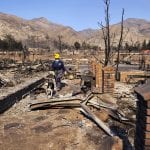Forensic Fire Investigation Helps Expose the Cause of Fires
 The Rim Fire that recently ravaged Yosemite National Park was started by a hunter’s illegal campfire, according to authorities.
The Rim Fire that recently ravaged Yosemite National Park was started by a hunter’s illegal campfire, according to authorities.
To determine the cause of such a fire, investigators rely on a number of observations and techniques, from telltale signs of flames to satellite imagery and chemical tests.
National Geographic spoke with Michael Sigman, the director of the National Center for Forensic Science at the University of Central Florida in Orlando. The center conducts academic research on the causes of fires and supports forensic fire investigators around the country with information and a database of materials.
How do investigators determine the causes of a fire with chemical methods?
Investigators on the scene take samples of debris and send it to a lab. There, you have to heat the material in an oven. Any ignitable liquid residues left will go into a vapor phase. These are collected, commonly with carbon strips. The liquid is taken off the strip with a solvent, then analyzed in a gas chromatograph with a mass spectrometer attached.
Once analysis is done, [investigators] compare the results to standard protocols. Unlike on TV shows, their job is simply to determine if the debris [contains] ignitable liquid. If [it tests] positive that doesn’t mean it was arson. [But the fire investigators] will try to assess what class of liquid it is, such as gasoline, petroleum distillates, oxygenated solvents, et cetera. And that will go to the authorities investigating the case.
What role does your center play in the process?
We don’t do testing for specific cases, but we developed an online database that labs use when they’re analyzing data from cases. We provide information on reference samples for different materials.
We also do research on topics important to the industry. For example, we’ve taken 50 ignitable liquids, evaporated them to various levels, and then reanalyzed that data, so investigators can start to understand how evaporated their sample might be.
If you have bacteria present, [that] can eat up some of the ignitable liquid, which can distort the results of a gas chromatograph. We’re looking at how biological degradation affects data.
How do you determine if a fire was set on purpose?
That’s [the investigator’s] role, not our role, which is keeping the science pure. You could find gasoline in fire debris, but maybe someone was cleaning the carburetor from their car on their kitchen table, so the presence of something doesn’t tell you why it was there.
To read the original article, click here.
